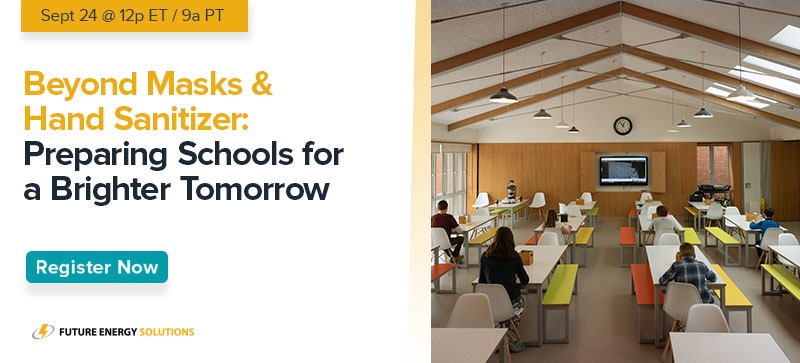As noted in a recent post, energy represents a considerable percentage of spending for all academic institutions -- from pre-school to massive university campuses and every other type of learning center.
“School budgets are in big trouble,” declared Chalkbeat, noting that a drop in state funding has put schools in peril, especially in low-income areas. Because schools get about half of their funding from their states, lower tax bases and higher costs of getting schools COVID-ready have created a funding crisis.
Many schools were built in the 1950s and 1960s. Despite upgrades over time, the age of these structures can present challenges. But even new schools are not necessarily greener. A U.S. Department of Energy report called “Myths About Energy in Schools” notes:
“During the rush to construct new buildings, schools often focus on short-term construction costs instead of long-term, life-cycle savings.”
Green school buildings -- both new structures and remodels -- are not only better learning environments, but can also save thousands of dollars annually that can be redeployed to staffing, programs, technology, and other student-facing improvements.
What is a Green School Building?
The Center for Green Schools defines a green school as one that:
- Reduces environmental impacts and costs
- Improves occupants’ health and performance
- Increases sustainability literacy
In other words, a green school isn’t just a structure that uses more sustainable alternatives in its physical environment, but one in which the academic community embraces the principles of energy-saving and cleaner operations.
K-12 schools spend roughly $8 billion annually in energy, about half of which is wasted, according to a report by the Environmental Protection Agency (EPA). Colleges and universities’ energy expenses total about $14 billion annually.
Energy consumption in and around school buildings include:
- Heating and air conditioning
- Lighting systems -- interior as well as parking structures and playing fields
- Refrigeration and heating in cafeterias
- Water heating and usage
- Electricity used to power technology like computer systems
- Transportation to and from schools
- Vending machine operation
About $20 billion savings could result over the next ten years if schools followed some basic principles for energy efficiency.
Why Now is a Good Time to Invest in Green School Buildings
Due to COVID-19, many schools are not operating at full capacity, combining classroom learning with at-home education. Some institutions are still remote-only. Embarking on an energy-related project is more manageable when buildings aren’t full.
Additionally, parents and students alike are focused on health. Light, acoustics, and air circulation all play a role in keeping learners alert and focused and can stem the spread of disease.
This Harvard study details the nine core areas that comprise a healthy building, based on 30 years of comprehensive research. They are:
- Ventilation
- Air quality
- Thermal health
- Moisture
- Dust and pests
- Safety and security
- Water quality
- Noise
- Lighting and views
By managing all of them, absenteeism is reduced, and productivity increases.
How to Start a Green School Building Initiative
The movement to greening your community’s schools can come from any direction. School administrators and facility managers have the most significant financial incentive. Still, once parents and students realize that cost savings are just one component of a green school movement, they will buy-in to the concept. For example, as school quality improves, so do property values.
Do Your Homework
Review case studies and associated results from other schools like yours that have embarked on green school building projects. The Green Ribbon Schools program is an excellent place to identify other institutions that have made progress.
Learn the language around the sustainable school initiative. For example, LEED-certified schools meet specific standards. But you may choose to take small steps towards sustainability, building support of decision-makers and your community before achieving a LEED level.
Make a Plan
This comprehensive checklist provides ideas and resources for each stage of your green school journey.
Remember, you can start with one or two categories of cost savings and health improvement rather than doing it all at once.
An energy audit is a critical component of your planning process. Look at every cost item related to energy and talk to experts about how to reduce each line. (See “Engage Partners,” below.)
Enlist Your Green Team
Parents, teachers, community organizations, legislators, environmental groups, and even local real estate professionals can be vital contributors to and supporters of your efforts.
Remember, too, that the greening of a school is not just about cost savings but also the future health and long-term sustainability of your community. Brainstorm the programs you will invest in with the dollars you save. Develop a curriculum around green practices and look for opportunities to teach parents and influencers as well.
Involve your students in your efforts. Especially in higher grades and at the college level, students can help champion your actions and even help you measure and report green building programs’ effectiveness.
Engage Partners
Trusted vendors, green school initiatives, and conferences are excellent sources of data and green building ideas and trends.
Grants may be available for energy-related projects. Research them carefully, study previous recipients, and make a strong case for your school.
Zero cost is as appealing as zero waste for cash-strapped schools and districts. Many vendors are willing to absorb the full cost of an energy-saving initiative. For example, FES Lighting Solutions has worked with many educational institutions. Not only do we perform a no-cost audit of current lighting expenses, but we also cover the entire cost of an LED lighting conversion and ongoing maintenance.
Share Your Successes
Measurement of cost savings over time will help turn naysayers into advocates. Develop a simple system for monitoring and reporting budget impact and note how your school or district is spending those precious dollars.
Also, track the impact of green improvements on your student and faculty population’s health -- absenteeism, test scores, teacher satisfaction, and employee engagement.
Ensure that local media and legislators are aware of the steps you’ve taken to improve your learning environment.
Wave your green school flag proudly, and centers of learning will eventually reduce waste, improve student and teacher health and performance, and set new energy and educational standards for tomorrow’s learners and educators. Plus, we’ll move closer to saving that $20 billion over the next ten years.
Start your energy management education here. Learn more about LED lighting for schools, and get your free lighting audit.
Learn how to prepare your school for a brighter tomorrow.


%20(1).png?width=1080&height=1080&name=FES-Ebook-1%20(1)%20(1).png)